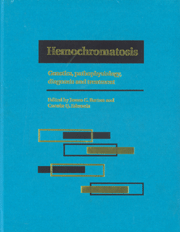Book contents
- Frontmatter
- Contents
- List of contributors
- Foreword
- Part I Introduction to hemochromatosis
- Part II Genetics of hemochromatosis
- Part III Metal absorption and metabolism in hemochromatosis
- Part IV Diagnostic techniques for iron overload
- Part V Complications of iron overload
- Part VI Therapy of hemochromatosis and iron overload
- 31 Management of hemochromatosis
- 32 Chelation therapy in iron overload
- 33 Liver transplantation and hemochromatosis
- 34 Survival in hemochromatosis
- Part VII Infections and immunity in hemochromatosis
- Part VIII Hemochromatosis heterozygotes
- Part IX Relationship of hemochromatosis to other disorders
- Part X Animal models of hemochromatosis and iron overload
- Part XI Screening for hemochromatosis
- Part XII Hemochromatosis: societal and ethical issues
- Part XIII Final issues
- Index
33 - Liver transplantation and hemochromatosis
from Part VI - Therapy of hemochromatosis and iron overload
Published online by Cambridge University Press: 05 August 2011
- Frontmatter
- Contents
- List of contributors
- Foreword
- Part I Introduction to hemochromatosis
- Part II Genetics of hemochromatosis
- Part III Metal absorption and metabolism in hemochromatosis
- Part IV Diagnostic techniques for iron overload
- Part V Complications of iron overload
- Part VI Therapy of hemochromatosis and iron overload
- 31 Management of hemochromatosis
- 32 Chelation therapy in iron overload
- 33 Liver transplantation and hemochromatosis
- 34 Survival in hemochromatosis
- Part VII Infections and immunity in hemochromatosis
- Part VIII Hemochromatosis heterozygotes
- Part IX Relationship of hemochromatosis to other disorders
- Part X Animal models of hemochromatosis and iron overload
- Part XI Screening for hemochromatosis
- Part XII Hemochromatosis: societal and ethical issues
- Part XIII Final issues
- Index
Summary
Introduction
Liver transplantation has become the treatment of choice of end-stage hepatic disease with long-term survival results better than any other therapeutic modality previously available. Because hemochromatosis is one of the most common genetic disorders and cirrhosis is of tenpresent at the time of diagnosis, it might be expected that hemochromatosis would be a common indication for liver transplantation. In fact, reports of liver transplantation for hemochromatosis continue to be a collection of case reports, and large centers report that hemochromatosis is an uncommon indication for transplantation. Liver transplantation is not only a life-saving procedure for the patient, but may provide new insights into the pathogenesis of the hemochromatosis. The development of a DNA-based genetic test for the gene for hemochromatosis (HFE) has the potential to improve the diagnostic precision of making a diagnosis of hemochromatosis in the setting of end-stage hepatic disease.
Pre-transplant diagnosis of hemochromatosis
It has been increasingly recognized that end-stage hepatic disease of diverse etiologies can be associated with iron overload at the time of liver transplantation. In a series of 447 explant livers, 8. 5% had iron overload in the range associated with hemochromatosis. Surgical and intrahepatic portosystemic shunts may also contribute to iron overload. A series reported by Kowdley et al. suggested that 30% of patients with hemochromatosis coming to liver transplant had the diagnosis made at the time of transplantation. All of these cases raise the question of what were the diagnostic criteria used to establish the diagnosis of hemochromatosis? If the diagnoses were based on hepatic iron concentration and hepatic iron index, it is likely that many cases of ‘hemochromatosis’ may have, in truth, been secondary iron overload.
- Type
- Chapter
- Information
- HemochromatosisGenetics, Pathophysiology, Diagnosis and Treatment, pp. 355 - 358Publisher: Cambridge University PressPrint publication year: 2000



